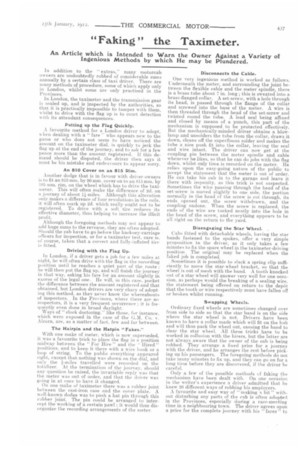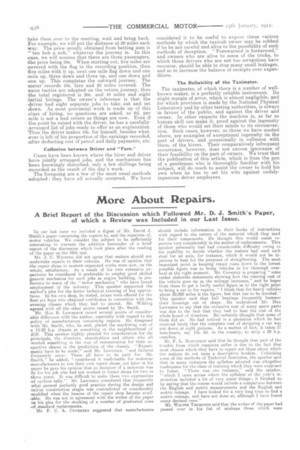" Faking " the Taximeter.
Page 15

Page 16

If you've noticed an error in this article please click here to report it so we can fix it.
An Article which is Intended to Warn the Owner Against a Variety of Ingenious Methods by which He may be Plundered.
In addition to the " extras," many motorca,b owners are undoubtedly robbed of considerable sums annually by a certain class of taxi driver. There are many methods of procedure, some of which apply only in London, whilst some are only practised in the Provinces.
In London, the taximeter and the transmission gear is sealed up, and is inspected by the authorities, so that it is practically impossible to tamper with them, whilst to drive with the flag up is to court detection with its attendant consequences.
Putting up the Flag Quickly.
A favourite method for a London driver to adopt, IN hen dealing with a "fare " who appears new to the game or who does not seem to have noticed the amount on the taximeter dial. is quickly to jerk the flag up at the end of the journey, and to ask for a few pence more than the amount registered. If this demand should be disputed, the driver then says it must be his mistake and endeavours to appear sorry.
An 810 Cover on an 815 Rim.
Another dodge that is in favour with driver-owners is to fit an 810 mni. by 90 mm. cover on to an 815 mm. by 105 mm. rim, on the wheel which has to drive the taximeter. This will often make the difference of 2d. on a journey of about 11 miles. Although this alteration only makes a difference of four revolutions in the mile, it will often mark up 2d. which really ought not to be registered. To drive with a soft tire reduces its effective diameter, thus helping to increase the illicit profit.
Although the foregoing methods may not appear to add huge sums to the revenue, they are often adopted. Should the cab have to go before the hackney-carriage officers for inspection, or for a taximeter test, care is. of course, taken that a correct and fully-inflated tire is fitted.
Driving with the Flag Up.
In London. if a driver gets a job for a few miles at night, he will often drive with the flag in the recording position until he reaches a quiet part of the route ; he will then put the flag up, and will finish the journey in that way, asking his fare for an amount slightly in excess of ate legal one. He will, in this case, pocket the difference between the amount registered and that obtained, but London drivers are very chary of adopt • ing this method, as they never know the whereabouts of inspectors. In the Provinces, where there are no inspectors, it is a very frequent occurrence ; it is frequently even done in broad daylight.
Ways of "clock doctoring." like those, for instance.
which were exposed in the case of the Co. v. Alcorn, are, as a matter of fact, few and far between.
The Hairpin and the Hatpin "Fakes."
With one make of meter, which is now superseded, it was a favourite trick to place the flag in a position midway between the " For Hire " and the " Hired" positions, and to keep it there with a wire hook or a loop of string. To the public everything appeared right, except that nothing was shown on the dial, and only the -?-miles travelled were recorded on the totalizer. At the termination of the journey, should any question be raised, the invariable reply was that the meter was out of order, and that the driver was going in at once to have it changed.
On one make of taximeter there was a rubber joint between the cast-iron case and the cover plate. A well-known dodge was to push a hat pin through this rubber joint. The pin could be arranged to intercept the working of a certain pawl : it would thus disorganize the recording arrangements of the meter. Disconnects the Cable.
One very ingenious method is worked as follows. Underneath the meter, and surrounding the joint between the flexible cable and the meter spindle, there is a brass tube about 7 in. long; this is sweated into a brass-flanged collar. A set-screw, with a hole through its head, is passed through the flange of the collar and screwed into the base of the meter. A wire is then threaded through the head of the set-screw and twisted round the tube. A lead seal being affixed and closed by means of a punch, this part of the mechanism is supposed to be protected effectively. But the mechanically-minded driver obtains a blowlamp and unsolders the tube from the collar, draws it down, cleans off the superfluous solder and makes the tube a nice push fit into the collar, leaving the seal and wire intact. The driver can now get at the coupling pin between the meter spindle and cable whenever he likes, so that he can do jobs with the flag down, whilst only time is recorded on the meter. He relies upon the easy-going nature of the public to accept the statement that the meter is out of order. He can take his cab in to the garage and leave it there with impunity, as this trick is not suspected. Sometimes the wile passing through the head of the set-screw is moved slightly to one side, the portion normally in the head of the screw is cut through, its ends opened out, the. screw withdrawn, and the coupling undone. When the screw is replaced, the ends of the wire are tucked neatly into the hole in the head of the screw, and everything appears to be all right on the return to the yard.
Disengaging the Star Wheel. _ Cabs fitted with detachable wheels, having the star bands fastened to the spokes, offer a very simple proposition to the driver, as it only takes a few minutes to fix the spare wheel in the taximeter-driving position. The original may be replaced when the faked job is completed.
Sometimes it is possible to slack a spring clip sufficiently to move the star-wheel bracket, so that the wheel is out of mesh with the band. A tooth knocked out of a star wheel will answer very well for one occasion, as perhaps would the breaking of a sealing wire, the statement being offered on return to the depot that the tooth or wire respectively must have fallen off or broken whilst running.
Swapping Wheels.
Ordinary fixed wheels are sometimes changed over from side to side so that the star band is on the side where the star wheel is not. Drivers have been known to have a collar made which will fit on the hub and will thus pack the wheel out, causing the band to clear the star wheel. All these tricks have to be worked in collusion with the hirers, but the latter are not always aware that the owner of the cab is being robbed. They arrange a fixed price for a journey with the driver, and he arranges the rest before picking up his passengers. The foregoing methods do not take many minutes to fix up, and they can go on for a long time before they are discovered, if the driver be careful.
Only a few of the possible methods cf faking the mechanism have been dealt with. On one occasion in the writer's experience a driver admitted that he knew 28 different ways of robbing his employers.
A favourite and easy way of "making a bit." without disturbing any parts of the cab is often adopted in the Provinces, especially during a race-meeting time in a neighbouring town. The driver agrees upon a price for the complete journey with his " fares " to -take them over to the meeting, wait and bring back. For example, we will put the distance at 20 miles each way. The price usually obtained from betting men is 4` ten bob a nob," whatever the journey is. In this case, we will assume that there are three passengers, the price being 30s. When starting out, five miles are covered with the flag in the recording position, then five miles with it up, next one mile flag down and one mile up, three down and three up, and one down and one up. This completes the outward journey. The meter records 10s. fare and 20 miles covered. The same tactics are adopted on the return journey, thus the total registered is 20s. and 40 miles and eight initial hirings. The owner's inference is that the
• driver had eight separate jobs to take out and set • down. As most provincial work is made up of this class of hiring, no questions are asked, as 6d. per mile is not a bad return as things are now. Even if the point be raised with the driver, he has a carefully-arranged list of jobs ready to offer as an explanation. 'Thus the driver makes Ws. for himself, besides whatever is left of his proportion of the earnings recorded, .after deducting cost of petrol and daily payments, etc.
Collusion between Driver and "Fare."
Cases have been known where the hirer and driver have jointly arranged jobs, and the mechanism has been knowingly disturbed, only a few shillings being recorded as the result of the day's work.
The foregoing are a few of the most usual methods -adopted : they have all actually occurred. 'We have considered it to be useful to expose these various methods by which the taxicab owner may be robbed if he be not careful and alive to the possibility of such methods of deception. "Forewarned is forearmed," and owners who are alive to some of the tricks, to which those drivers who are not too scrupulous have recourse, should be able to stop many small leakages, and so to increase the balance of receipts over expenditure.
The Reliability of the Taximeter.
The taximeter, of which there is a number of wellknown makes, is a perfectly reliable instrument. Its slight margin of error, which is almost negligible, and for which provision is made by the National Physical Laboratory and by other testing authorities, is always in favour of the public, and against the driver and owner. In other respects the machine is, as far as human skill can make it, proof against the ingenuity of those who would set their minds to its circumvention. Such cases, however, as those we have quoted above, are examples of exceptional ingenuity on the part of drivers, and occasionally in collusion with them, of the hirers. Their comparatively infrequent occurrence, however, does not excuse ignorance of their feasibility on the part of owners. We trust that the publication of this article, which is from the pen of a gentleman who is thoroughly familiar with his subject, will do much to assist the owner to hold his own when he has to set his wits against undulyingenious driver employees.






















